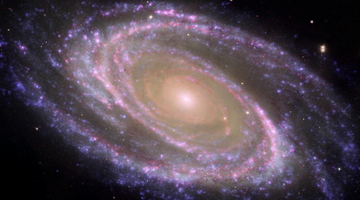Elements are formed deep within the cores of certain types of star. Find out more in this interactive.

“We’re literally the ashes of long dead stars,” says Sir Martin Rees, Professor of Cosmology and Astrophysics, University of Cambridge. As stars evolved in space after the Big Bang, nuclear reactions occurred that transformed hydrogen and helium, formed as a result of the Big Bang, into the elements as we know them.
Click on each stage of the star life cycle and discover how the elements that we are all made up of were created.
Transcript
Stellar nebula
Moments after the Big Bang, energy begins to condense into matter, protons and neutrons are formed, and then the first element (hydrogen) is formed. Hundreds of millions of years later in stellar nebulae, the hydrogen gas clouds coalesce and, under gravity, form protostars. Nuclear fusion processes begin converting hydrogen into helium. One example of a stellar nursery is the Eagle Nebula.
Acknowledgement: T.A.Rector & B.A.Wolpa, NOAO/AURA/NSF
Average star
An average or medium star is less than 3 times the mass of the Sun. Stars are powered by nuclear fusion in their cores, mostly converting hydrogen into helium and liberating tremendous amounts of energy.
Acknowledgement: JPL-Caltech National Aeronautics and Space Administration (NASA)
Massive star
Massive stars, more than 3 times the mass of the Sun, mostly convert hydrogen into helium. Rigel is the brightest star in the constellation called Orion and one of the brightest stars in the sky. It is a blue (very hot) supergiant, over 100 times bigger than the Sun.
Acknowledgement: Glen Youman
Red giant
As medium sized stars exhaust their hydrogen content, they expand up to 100 times their original size to become red giants. The nuclear fusion reactions occurring within a red giant are H→ He and He→ C. Our Sun will follow this path over the next 5 billion years. This red giant is Aldebaran in the constellation Taurus.
Acknowledgement: NASA
Super Red giant
Supergiants are the element factories of our universe. The nuclear fusion reactions occurring are H→ He, He→ C, C→ Ne, Ne→ O, O→ Si and Si→ Fe.
Betelgeuse in the constellation Orion is a super red giant. It is about 20 times as massive as the Sun. The lifetime of this type of star is relatively short by comparison with the Sun – millions of years as opposed to billions of years.
Acknowledgement: A.Dupree and R.Gillard (CfA), R.Gilliland (STScI)
Planetary nebula
A planetary nebula is a huge shell of gas and dust ejected during the last stage (red giant) of the life of a medium star. Elements such as helium, carbon, oxygen, nitrogen, neon and smaller amounts of heavier elements are present. Planetary nebulae play an important part in the chemical evolution of the galaxy, allowing these elements to be returned to the interstellar medium. The remains of the carbon core of a red giant evolve into a white dwarf star. The Eskimo Nebula in Gemini is a good example.
Acknowledgement: Andrew Fruchter, STScI Andrew Fruchter
Supernova
From the cataclysmic explosion of the supernova, the heavier elements form.
The supernova is the final stage in the life of massive stars. The outer region of the star collapses and it Instantly rebounds off the inner core in a cataclysmic explosion. The extremely high level of energy allows further fusion reactions to occur, producing heavy elements like gold, silver and uranium. The supernova image shows Tycho’s Supernova Remnant – this expanding gas cloud is all that remains after a star went supernova. In 1572, Danish astronomer Tycho Brahe noticed the presence of a ‘new’ bright light in the night sky and recorded its position and intensity in his writings. It has been named in his honour.
Acknowledgement: APOD/NASA/CXC/SAO
White dwarf
A white dwarf is a small, very dense, hot star that is made mostly of carbon. These faint stars are what remain after a red giant star loses its outer layers. They are about the size of the Earth and will eventually lose their heat to become a cold, dark black dwarf. The sun will eventually turn into a white dwarf and then a black dwarf.
Acknowledgement: NASA and H.Richer (University of British Columbia)
Neutron star
Stars with a mass between 1.5 and 3 times the mass of the sun will end up as neutron stars. A neutron star is a very small, super-dense star that is composed mostly of tightly packed neutrons. A rapidly spinning neutron star is known as a pulsar.
Acknowledgement: NASA
Black hole
Black holes are all that remain after stars with masses over 3 times that of the sun supernova. A black hole is a massive object (or region) in space that is so dense that, within a certain radius (the Schwarzschild radius determines the event horizon), its gravitational field does not let anything escape from it – not even light.
Acknowledgement: Alain r - Own work, CC BY-SA 2.5
Elements, planet Earth and us
“We are literally the ashes of long dead stars.” Scientists believe that the Solar System was formed when a cloud of gas and dust in space, made up of elements formed deep within stars, started to collapse, forming a solar nebula. This began to spin as it collapsed, eventually giving birth over billions of years to the Solar System as we know it today. Apart from hydrogen and helium, formed just after the Big Bang, most of the elements we come into contact with have been made in the stars. Planet Earth and all of its life forms are made of elements formed billions of years ago deep within the cores of stars now long dead.
Acknowledgement: MediaCollege.com






